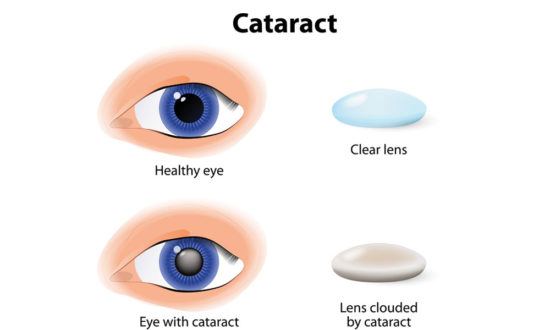
We probably all know someone who’s suffered from cataracts and some of us may have them ourselves. Cataracts affect more than 22 million Americans ages 40 and older and are present in 90 percent of Americans 65 and older, with the most common cause of cataracts being age related.
A popular misconception is that a cataract is a “film” that forms over the surface of the eye. In reality, it is a change that happens in your eye — the proteins that make up the lens begin to clump together, which blocks light from passing through and clouds and blurs your vision.
Cataracts usually develop slowly and painlessly and you might not notice your vision changing. Symptoms include blurred vision, faded or dull colors, poor night vision and sensitivity to light.
Generally, cataracts don’t harm the eye, and often can initially be corrected with prescription glasses. However, the Mayo Clinic says, “most eye doctors suggest considering cataract surgery when your cataracts begin to affect your quality of life or interfere with your ability to perform normal daily activities, such as reading or driving at night.”
While cataract surgery clears up your vision, it also changes the way you see things. Whether you are nearsighted (this is most common) or farsighted, the types of intraocular lenses implanted during surgery, and how they affect the eye, are the same.
Typically, one of three types of intraocular lenses is implanted during cataract surgery:
While being able to see better means your entire life changes for the better, it also means your favorite hobbies will be more enjoyable. And if your work or hobbies involve detail-oriented activities, there’s no reason you need to wait until after your cataract surgery to start seeing better and enjoying your craft.
Many CraftOptics customers who learn they have cataracts don’t get the surgery right away, either due to the early stage nature of their cataracts or simply due to far off scheduling. This is very common, and while the condition can be distressing, but it doesn’t mean you have to give up your work or hobbies. In the months leading up to surgery, we install your current prescription in your CraftOptics frames. That, the magnification and light all help to overcome some of the early vision challenges from cataracts until time of surgery.
After the surgery, the eyes need a month or so to settle before a new prescription can be accurately refracted, at which point that new correction gets installed into your existing CraftOptics magnifying eyeglasses frames.
If cataracts are affecting your vision to the point where your artwork is being affected, perhaps we can help. We’d love to hear from you. This infographic and article provides more details and information: Cataract Information